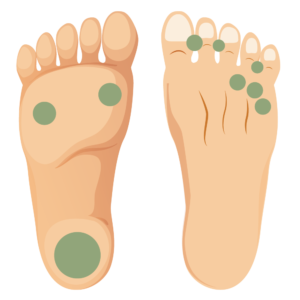
Typically corns and calluses are caused by friction from repetitive motions. Some examples of this are:

Individuals who suffer from the following conditions may be more at risk for corns and calluses:
If you have a corn or callus that is not painful, it may not require medical attention right away. Some individuals that have corns or calluses that aren’t painful choose to have them addressed anyway because they are unsightly.
If you have a corn or callus that becomes very painful or inflamed, or has broken open and is bleeding, call your podiatrist right away. If a corn starts discharging pus or clear fluid it is infected and needs to be addressed by a podiatrist right away. It is always recommended that you do not try to remove a corn or callus on your own, however it is even more important to go to a podiatrist for treatment if you have diabetes or poor blood-flow. Self-treating corns and calluses could result in an open injury that could quickly become infected.
Whether your corns and/or calluses are painful or just unsightly, we are here to help! At your initial appointment Dr. Squires will learn more about you, your lifestyle, and how your corns and/or calluses are affecting you. She will evaluate the shoes that you wear and make sure that they are the best fit for your feet – and the right size! If necessary, Dr. Squires will be able to recommend brands of shoes that may work better for you (one brand does not fit all).
In addition to reviewing your shoes, Dr. Squires may recommend x-rays to determine whether or not your corns and/or calluses are being caused by a physical deformity. After determining the root cause, a treatment plan will be developed based on your lifestyle and goals. Some corns and calluses will only need a conservative approach, such as shoe correction or protective pads that we have in-office. Other corns and calluses may need more in-depth treatment, such as trimming down the excess skin, medication, or even surgery. The best way to determine the most effective treatment plan that will benefit you most in the long run is to make an appointment to see Dr. Squires.